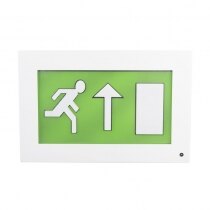-
Contact
Sales & Customer Service
0800 612 6537 support@safelincs.co.uk Live ChatDelivery Enquiries
0800 077 6149 - Resources
Fire & Safety Solutions
CALL OUR TEAM NOW 0800 612 6537
Also FREE from UK mobiles
FREE Delivery
on marked products
Live Chat - Online
Instant help & Advice
Trade Discounts
and exclusive pricing
0% Credit Available
Open an account now
5 Star Customer Feedback
All Emergency Lighting
When darkness falls or power fails, emergency lighting becomes your lifeline. These essential safety systems guide people to exits, illuminate escape routes, and maintain visibility during critical moments. Whether you're protecting a small office or a large commercial building, the right emergency lighting can mean the difference between chaos and calm evacuation. From exit signs and bulkhead lights to advanced LED systems, emergency lighting must comply with BS 5266 standards and provide at least three hours of illumination during power failures. What types of emergency lighting are available? Emergency lighting comes in various forms, each designed to meet specific safety needs. Exit signs mark escape routes with bright, unmistakable symbols. Bulkhead lights provide general illumination across corridors and open areas. Downlights offer focused lighting for stairwells and walkways. Floodlights provide powerful illumination for large spaces, such as warehouses or car parks. You'll also find specialised options, such as twin spotlights that focus on two key areas, and IP65-rated units built to withstand harsh environments. LED technology has revolutionised these systems, offering longer life spans, lower energy consumption, and brighter output than traditional alternatives. How long do emergency lights need to run? Most emergency lighting systems must provide illumination for at least three hours after mains power failure. This duration allows sufficient time for safe evacuation and emergency response. Some applications require extended operation times, particularly in buildings where occupants might need to remain inside during emergencies. Battery backup systems power these lights during outages. Modern units use maintenance-free batteries that automatically charge when mains power is available and switch on instantly when needed. Regular testing ensures these systems work when every second counts. Where should emergency lighting be installed? Strategic placement is crucial for the effective use of emergency lighting. Every exit door needs clear illumination, along with the routes leading to these exits. Stairwells, corridors, and any changes in floor level require lighting to prevent accidents during evacuation. Open areas exceeding 60 square metres require emergency lighting to assist people in navigating safely. Fire alarm call points, fire extinguishers, and first aid stations also need illumination so people can locate these vital resources during emergencies. Don't forget toilets and lift cars, where people could become trapped without lighting. What regulations apply to emergency lighting? British Standard BS 5266 sets out the requirements for emergency lighting systems. These standards encompass a range of aspects, including light levels and duration, as well as testing procedures and maintenance schedules. Regular testing is mandatory, with monthly function tests and annual duration tests required by law. The standards also specify minimum illumination levels along escape routes and at key decision points. Emergency lighting must activate automatically when the mains supply fails and provide adequate light for safe movement. Compliance isn't just about meeting legal requirements; it's about protecting lives and ensuring the well-being of individuals. How do you maintain emergency lighting systems? Regular maintenance ensures that emergency lighting systems remain reliable when you need them most. Monthly visual inspections ensure damage is detected, lenses are positioned correctly, and lenses are clean. The brief test function verifies that lights activate properly and batteries hold a charge. Annual full-duration tests ensure batteries can power the system for the required time. Keep detailed records of all tests and maintenance activities. Replace batteries according to manufacturer recommendations, typically every four to five years, and address any faults immediately. Ready to protect your building with reliable emergency lighting? Browse our comprehensive range of emergency lighting systems, from basic exit signs to advanced addressable networks. Our expert team can help you select the ideal solution for your specific needs and ensure complete compliance with current regulations. Frequently Asked Questions (FAQs) What's the advantage of LED emergency lighting over fluorescent? LED emergency lights use much less power than fluorescent alternatives, reducing your energy costs. They also last much longer - over 50,000 hours compared to just a few thousand for fluorescent bulbs. The longer lifespan means less maintenance and fewer replacements, saving you time and money over the years. Can I install emergency lighting myself? Competent DIY enthusiasts can install some emergency lighting, but many installations require the services of qualified electricians. It depends on the complexity of your system and local building regulations. Self-contained units with integral batteries are often easier to install than central battery systems. However, all installations should comply with BS 5266 standards. For peace of mind and legal compliance, we recommend using qualified electricians for all emergency lighting installations. What's the lifespan of modern emergency lighting? LED emergency lights typically last 10-15 years or more with proper maintenance. The LED elements themselves can run for over 50,000 hours. Batteries usually require replacement every 3-5 years, which is considered routine maintenance. The light fittings themselves should last much longer. Regular cleaning and testing help maximise lifespan. Quality emergency lights are built to withstand years of reliable service with minimal maintenance. Do I legally need emergency lighting in my building? Yes, emergency lighting is legally required in most commercial buildings under British Standards BS 5266. This includes offices, shops, restaurants, hotels, and industrial premises. You'll also need emergency lighting in residential buildings, such as HMOs (Houses in Multiple Occupation), in communal areas like hallways, stairwells, and shared kitchens. The only exception might be if reliable external street lighting provides enough illumination for safe evacuation. However, this is rare and needs professional assessment. Where should I install emergency lighting in my building? Emergency lighting must illuminate all escape routes, including corridors, stairwells, and exits, to ensure the safety of occupants. You'll also need lights at changes of direction, near fire safety equipment, and at each exit door. Key areas include fire alarm call points, first aid stations, and any point where the route changes level or direction. The goal is to create a clear, well-lit path to safety. Our technical team can help you plan the right locations and quantities for your specific building layout. For more guidance on choosing between maintained or non-maintained emergency lights, check out our detailed comparison guide.
Read more about emergency lighting...
Double-Sided LED Emergency Fire Exit Sign with Downlight - Pescara
The Pescara series comes in a range of stylish finishes that will suit any interior. An opal downlight panel casts additional light on your escape route in the event of power loss.
- Double-sided, suitable for surface mounting or suspending from ceilings
- Designed for indoor installation – IP20 ingress protection
- Range of finishes - white, black, chrome and brass
Single-Sided LED Emergency Fire Exit Sign - Paloma
Suitable for wall mounting, the Paloma single-sided emergency LED fire exit sign is available in a range of finishes to suit your premises.
- Available in white, black, chrome or brass finishes
- Suitable for interior fire exit routes
- Clear threshold provides emergency lighting beneath the sign
Single-Sided LED Emergency Fire Exit Sign with Downlight - Pescara
The Pescara range of LED emergency fire exit signs offer high energy efficiency and come in a variety of high quality finishes to suit the style of your premises.
- Available in white, chrome, black and brass finishes
- Single-sided, suitable for surface mounting
- IP20 protection, ideal for indoor installations
Ultra Slim Double-Sided LED Emergency Fire Exit Sign - Petina
The Petina range of LED emergency fire exit signs is available in a choice of four different finishes designed to complement any interior.
- Slim 45mm depth with wide bezel design
- Variety of mounting options including ceiling suspension
- Zintec coated sheet steel construction
Ultra Slim Single-Sided LED Emergency Fire Exit Sign - Petina
The Petina LED emergency fire exit sign is ultra slim and available in a range of finishes to suit any sleek, modern interior.
- Choice of white, black, chrome and brass finishes
- Only 30mm deep with a wide bezel design
- High quality mild steel construction
Page 3 (45 of 45 Products)
Emergency Lighting Regulations
Emergency lighting legally required in most commercial and some residential buildings e.g. the communal areas of HMO's under British Standards BS 5266. These regulations ensure that in case of a power outage, clear, well-lit escape routes guide occupants to safety. An exception may be in the case of ‘borrowed’ light, where if the lights from external street lamps are a reliable source of lighting to illuminate escape routes, it can sometimes be considered sufficient. The British Standards specify where lights should be placed, what kind of lights are needed, and the testing requirements to ensure the systems are operational. Following these guidelines helps meet health and safety obligations while ensuring the safety of employees, visitors, and residents.
Maintained vs Non-Maintained Emergency Lighting
When choosing emergency lighting, it’s essential to understand the difference between maintained and non-maintained systems. Maintained emergency lights are designed to stay on continuously, making them suitable for areas like corridors and public spaces where lighting is required at all times. Non-maintained lights, on the other hand, only activate during power failures. These are commonly used in areas that don’t require constant lighting but still need to ensure safe evacuation during emergencies. Both types are integral to a building's overall safety plan.
LED Emergency Lighting
LED emergency lighting offers significant advantages over traditional lighting systems, particularly in terms of energy efficiency and longevity. LEDs consume less power, helping reduce energy costs, while providing bright, reliable illumination for emergency situations. Additionally, LED lights have a longer lifespan, requiring less frequent replacements, which minimises maintenance. These benefits make LED emergency lighting a practical and environmentally friendly choice for both commercial and residential premises, ensuring safe evacuation routes with minimal environmental impact.






















